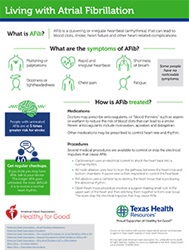What is Atrial Fibrillation?

During atrial fibrillation (AFib), imagine that it’s like an off-beat drummer who’s not in sync with the rest of the band. The heart’s atria, or the two upper chambers, beat irregularly compared to the heart’s two lower chambers. This can cause a variety of symptoms, including shortness of breath, fatigue, heart palpitations and chest pain.
But the majority of people with AFib have no symptoms, says Dr. Ashesh Parikh, a non-interventional cardiologist at Texas Health Heart & Vascular Specialists, a Texas Health Physicians Group practice in Plano. “Doctors usually catch it via an electrocardiogram, or EKG, or by checking your pulse and noticing it’s irregular.”
Thanks to newer technologies, however, which include FDA-approved smartwatch apps that can alert users to an irregular heartbeat, Parikh says he has seen several asymptomatic patients who proactively sought treatment over the past few months.
Being proactive about seeking treatment for AFib may help to avoid AFib’s most dangerous outcomes, Parikh says, which include tachycardia-induced cardiomyopathy, heart failure and stroke.
Indeed, people with untreated AFib have five times higher risk of stroke. According to the Centers for Disease Control and Prevention, AFib is responsible for about 1 in 7 strokes.
“Because the blood is not constantly being pushed by the squeeze of the atria, it pools in crooks, crevices and pouches in the heart’s top two chambers, where it can turn into a clot,” Parikh says. “If that clot moves from the atria, it can go into the ventricle, or lower chamber, and straight up the carotid artery to the brain.”
Clots also can dislodge and travel to other parts of the body, cutting off blood flow and potentially causing organ failure, amputation or even death.
In certain cases, AFib may go away on its own. But many people require treatment. Classes of medications available to treat AFib include:
- Anticoagulants, also called blood thinners.
- Beta blockers and calcium channel blockers, which slow the heart rate.
- Sodium channel blockers and potassium blockers, which can restore a proper rhythm.
A variety of non-surgical and surgical procedures also are available to treat AFib. They include:
- Cardioversion, in which electrodes placed on the chest apply an electric current to shock the heart back into a normal rhythm.
- PVI ablation, where a catheter is used to destroy the heart tissue that is producing abnormal currents. Usually, this results in the return of normal heart rhythms.
- AV node ablation uses a catheter to cauterize (burn) the pathway that connects the top and bottom chambers of the heart, essentially severing the link and cutting off all communication.
“After an AV node ablation, you are dependent 100% on a pacemaker for your heartbeat, but it gets rid of your AFib symptoms permanently,” Parikh says, noting it’s typically a last resort.
More recently, the FDA approved a mesh device designed to close the left atrial appendage, where blood is most likely to clot. This reduces stroke risk and eliminates the need to take a blood thinner.
Are you at Risk?
Since the risk for AFib increases with age, Parikh advises to start having an annual EKG when you turn 45 and see a cardiologist if you have chest pain or tightness in the chest.
A history of high blood pressure, diabetes, sleep apnea or underlying heart or vascular disease also raises the risk. Smoking, drinking high-caffeine energy drinks and moderate or heavy alcohol consumption can bring on AFib as well.
While being diagnosed with AFib may be overwhelming at first, Parikh points to the great advances in medicine and procedures as reasons for hope. With proper management, most people with AFib can still exercise and do their daily activities.
“I always provide reassurance to my patients that as long as you’re taking your blood thinner, even if you’re having symptoms, AFib is not life-threatening,” he says. “Everything else is manageable.”
If you suspect you have symptoms of AFib, find a heart and vascular specialist today.
Common Medications for AFib
Blood Thinners
Examples: aspirin, coumadin or xeralto
Often the first line of defense, blood thinners reduce the risk of clotting and, therefore, stroke. However, they can increase the risk of bleeding in some patients, particularly older people, who are at the greatest risk of developing AFib.
Beta Blockers
Examples: atenolol and timolol
Beta blockers work by blocking adrenaline, which slows down the heartbeat. This lowers blood pressure and enhances blood flow through the veins and arteries.
Calcium Channel Blockers
Examples: diltiazem and verapamil
Calcium channel blockers slow down the heart rate, which reduces the strength of the heart’s contraction.
Sodium Channel Blockers
Examples: flecainide, propafenone and quinidine
Once the heart rate is under control, sodium channel blockers can help restore a proper rhythm. These medications work by slowing the heart’s ability to conduct electrical currents.
Potassium Channel Blockers
Examples: amiodarone, sotalol and dofetilide
Similar in effect to sodium channel blockers, potassium channel blockers help maintain normal heart rhythm by slowing down the heart’s electrical signals.
Texas Health Physicians Group providers are employed by Texas Health Physicians Group and are not employees or agents of Texas Health Resources hospitals.
Doctors on the medical staffs practice independently and are not employees or agents of Texas Health hospitals or Texas Health Resources.

